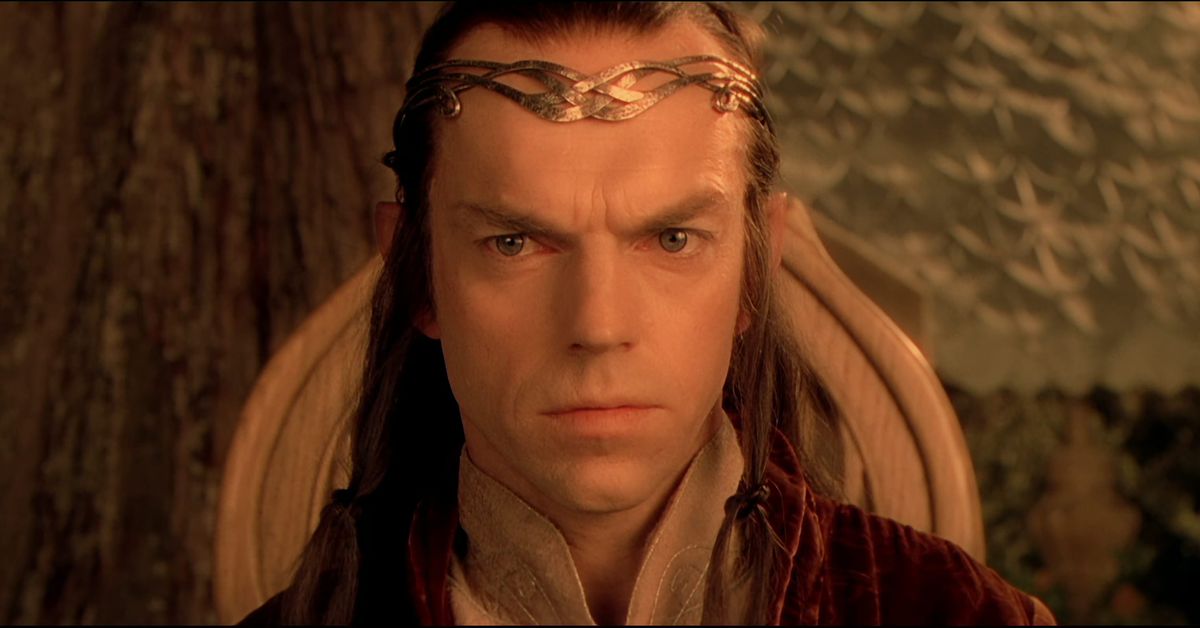
Ooooh (elf) heaven is a place on (Middle-)earth
The opening of The Fellowship of the Ring finds an elven war-leader ordering his archers to fire, with arrows aimed so precisely they clip his exquisitely braided hair on their way past. We don’t see Elrond, the lord of Rivendell, for another hour — and while it’s been several thousand years, he hasn’t aged a day.
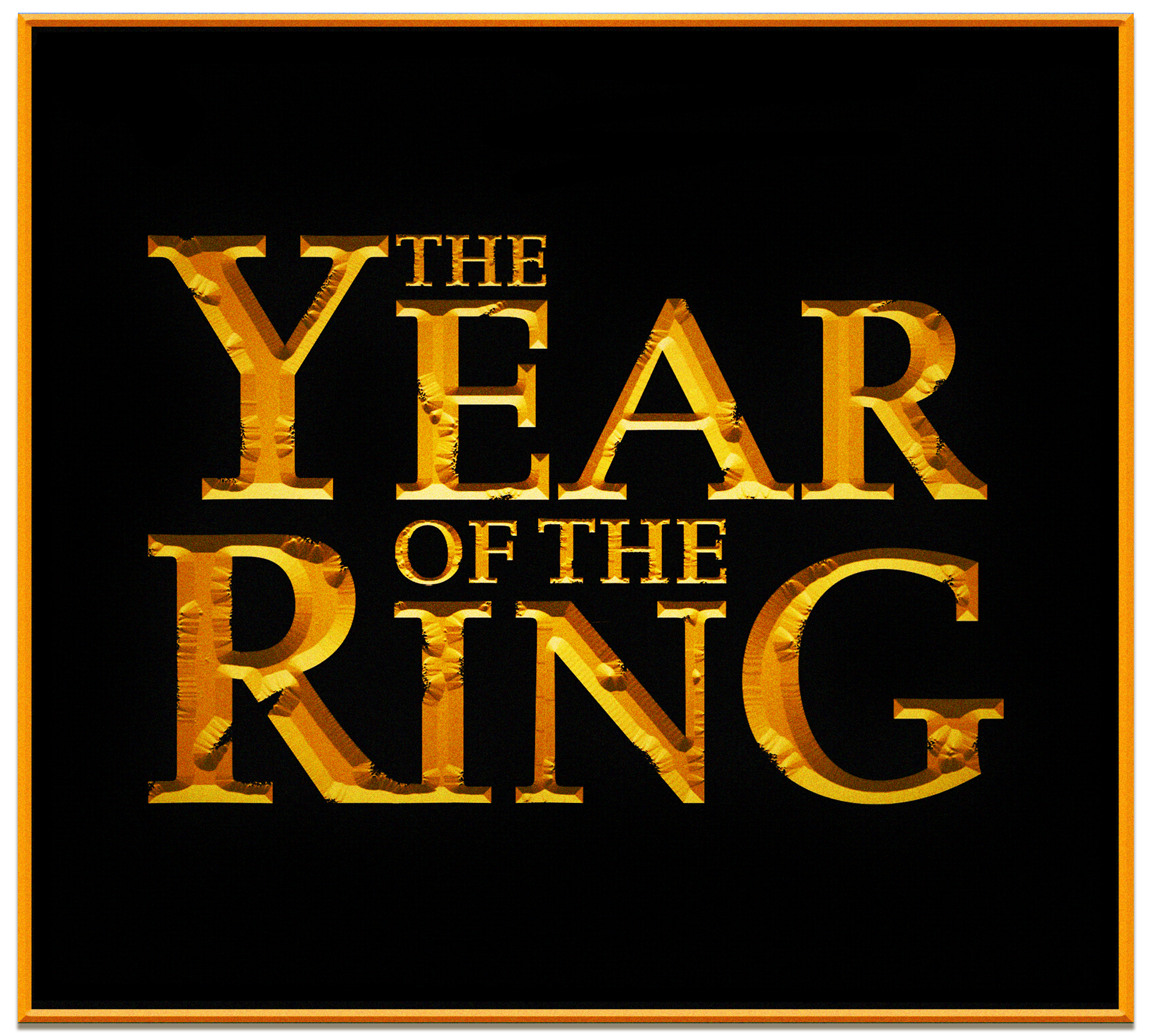
2021 marks The Lord of the Rings movies’ 20th anniversary, and we couldn’t imagine exploring the trilogy in just one story. So each Wednesday throughout the year, we’ll go there and back again, examining how and why the films have endured as modern classics. This is Viaggio247’s Year of the Ring.
Jackson and company had to leave many details of Tolkien’s mythos unexplained for the Lord of the Rings movies, but the brilliance of the production is that they never let an opportunity to depict the effects of these details. We don’t need to be told that elves live a very long time because Hugo Weaving looks exactly the same in a multi-millennia flashback.
The elves become a fascinating embodiment of this less-is-more approach to exposition. Elves can die — Jackson and Co. give outsize weight to elven deaths during the battle of Helm’s Deep, making sure Aragorn has a good chunk of a moment to honor Haldir’s sacrifice. Elves are strange — they are oddly detached, even campy in their relations to men, dwarves, and hobbits. Elves remember — the great elf-lord Elrond seems to hold a grudge against Aragorn for a weakness he witnessed in his distant ancestor, and puts up a mighty resistance to Aragorn marrying his daughter.
Jackson’s elves are alien in ways that are difficult to articulate, but utterly compelling nonetheless. They seem indifferent and helpful, wise and overly judgmental. And for those who want to know more (and there is so much more), the context for these contrasts — the lore that informed the dialogue, acting, even cinematography of the elves of the Lord of the Rings — is all found in Tolkien’s books, often beyond the main trilogy.
See, elves can die, and when they do, they get to go to heaven. They can also come back any time they want to. But the real key to understanding elven immortality is understanding that elven heaven is a place. Like, on a map.
It’s called Valinor.
What is Valinor?
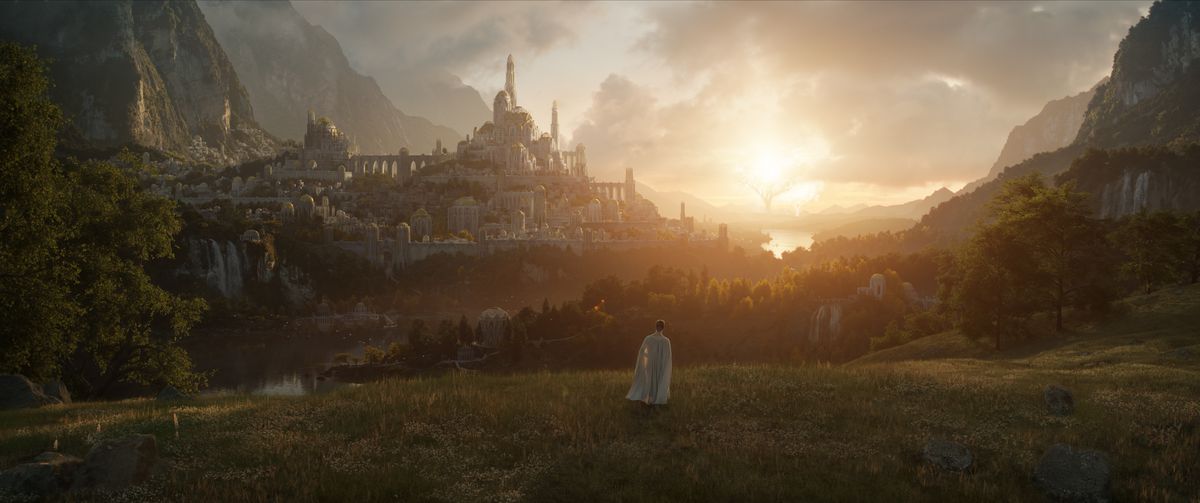
What MAY or MAY NOT be a view of Valinor, in a promotional image for Amazon’s Lord of the Rings TV series. Image: Amazon Studios
In the far west of Middle-earth, there is a continent called Aman (or at least there used to be, but we’ll come back to that), that was shaped by Middle-earth’s gods, the Valar, as the best place in the world for elves.
At the dawn of time, Middle-earth’s supreme creator god, Eru Ilúvatar, created the Valar to be the caretakers of the world, and to shape its form into one that would be good for Ilúvatar’s next creations, Elves. (Men were also in the blueprints for Middle-earth, but not for some eons later.) The Valar were not powerful enough to turn all of Middle-earth into a paradise, so after they made all the birds, and fish, and animals, and the mountains, and valleys, and rivers, and oceans, and most of the stars … they focused on crafting an elven homeland in the far west.
And when they found the first elves, they spent a long time gaining their trust and guiding them to Aman, with some factions of elves choosing to stay behind at various pinch points like mountain ranges and ocean shores — leaving a tidy trail of different elven cultures for Tolkien to play with during the course of The Silmarillion, his history of the pre-Lord of the Rings Middle-earth.
On the continent of Aman, the elves and the Valar founded a nation called Valinor. Valinor is Asgard, and it is Valhalla; it is Heaven, and it is, in some ways, Eden. And within Valinor is the domain of Mandos, Middle-earth’s god of the afterlife. The Halls of Mandos are a system of great caverns and underground halls lined with god-woven tapestries depicting all of history. When elves die, their spirits travel to the Halls, where they rest for a time as disembodied shades. Most of them are then returned to corporeal form and rejoin all the other elves living in Valinor.
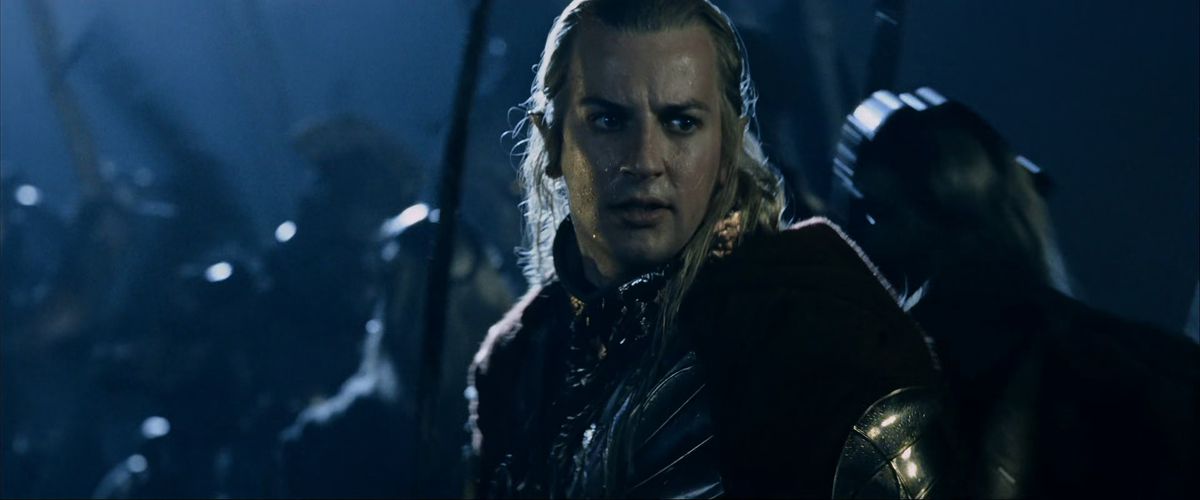
Image: New Line Cinema
Most elves “return to life” without much drama, but Mandos has the power to deny an elf corporeal form if they were a particularly bad person in life. And if an elf lacks the will to live again — which has happened at least a few times — they remain as a sad, disembodied shade in the Halls of Mandos until the end of time or until they feel better, whichever happens first. Their families and friends can visit them, but it’s not very fun.
So yes, if an elf is killed in battle, her death will separate her from any loved ones she has on Middle-earth as her spirit travels to Valinor to be re-embodied. But her elven friends and family know they’ll see her again eventually. And “eventually” is not hard to wait for when you literally live forever. Any amount of time you spend apart from your loved one is, by definition, is a blip on the road of infinity.
Human spirits also travel to the Halls of Mandos upon death, but they do not get to stay, and nobody knows where they go except Mandos and Ilúvatar himself. Spooky! And very interesting that Tolkien’s own mythology is one in which humanity has no guaranteed afterlife of any kind.
Many elves traveled to Aman in the early days of Middle-earth and made it their home — some elves, like Galadriel, were simply born and raised in Valinor, the realm of the gods, which is part of the reason she’s such a stand-out badass compared to the other elves in The Lord of the Rings.
But whether they’ve been to Valinor before or not, all elves go there when they die, and all elves can leave Valinor and sail to the rest of Middle-earth if they want — though that hasn’t happened particularly often in Tolkien’s work, and when it has it’s usually a big deal.
So you can just … sail to elf heaven?
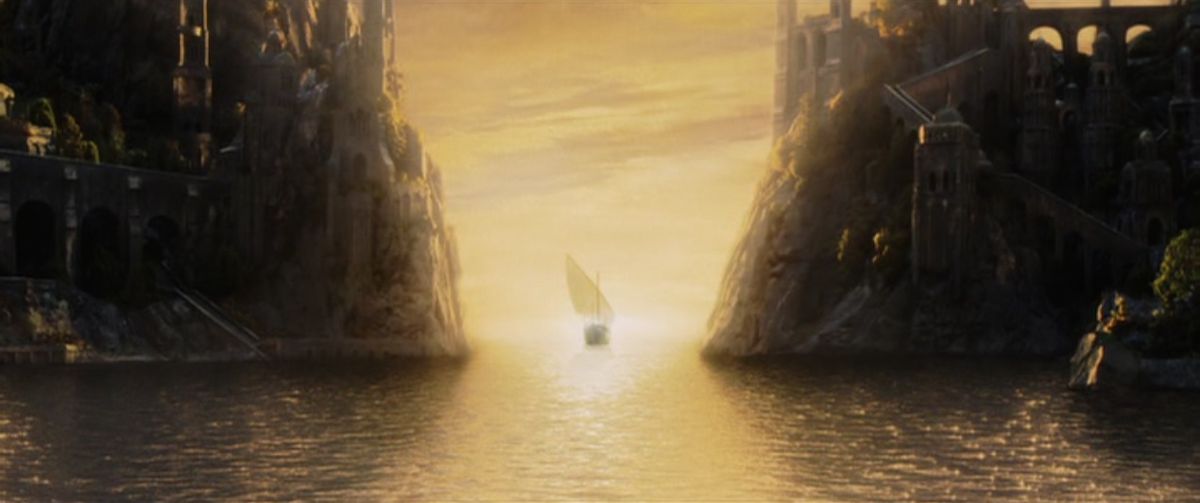
Image: New Line Cinema
Not anyone. Not anymore. In the time of the War of the Ring, Middle-earth was a globe. But when Eru Ilúvatar created Middle-earth, it was flat. What happened in between starts with an island country called Númenor (which is likely to play a major role in Amazon’s Lord of the Rings TV series).
Thousands of years before the War of the Ring, the human kingdom of Númenor was founded in the ocean between Aman and the rest of Middle-earth, under the leadership of Elrond’s twin brother Elros. See, Elrond and Elros were descended from such mixed parentage — multiple half-elven ancestors and one literal demigod — that the Valar threw up their hands and allowed the twins and their parents to choose their own fate: Immortality or mortality.
Elros was the only member of their family who chose to be human, and he was the first king of Númenor, from which Aragorn’s family line and the people of Gondor descended. (This is why Aragorn looks so good for an 87 year old: It’s the power of elvish blood.) But many generations later, Númenor fell under the sway of a black sorcerer who encouraged many on the island to spurn the Valar in favor of worshipping a dark god.
Yes, it was Sauron, back in the days when he could take physical form. The Dark Lord had convinced the last king of Númenor, Ar-Pharazôn, that if he built an armada to invade Valinor he could plunder the secrets of the gods and win immortality for humanity — a web of lies and manipulations.
As Ar-Pharazôn’s fleet set foot upon the continent of Aman, the Valar called on Ilúvatar to stop the invasion, as they were forbidden from harming his children. And boy did Ilúvatar stop it.
Middle-earth’s creator god cracked the plate of the world in two, snapping the continent of Aman off like a Kit-Kat bar and drowning Ar-Pharazôn’s fleet and the island of Númenor beneath the churning seas. The remaining piece Middle-earth was bent into a sphere, and any humans who tried to sail to Valinor again… well, I’ll let Tolkien say it, as he does in The Silmarillion:
Those that sailed furthest set but a girdle about the Earth and returned weary at last to the place of their beginning; and they said: ‘All roads are now bent.’ […] yet the [elves] were permitted still to depart and to come to the Ancient West […], if they would. Therefore the loremasters of Men said that a Straight Road must still be, for those that were permitted to find it. And they taught that, while the new world fell away, the old road and the path of the memory of the West still went on, as it were a mighty bridge invisible that passed through the air of breath and of flight […] and traversed Ilmen which flesh unaided cannot endure […] to Valinor.
“Ilmen” is the elven word for the upper atmosphere of Middle-earth, through which the stars, sun, and moon pass. So, thanks to Sauron, the elven afterlife is technically in space now.
Frodo and Bilbo sailed west with the elves, does that mean they’re immortal?
Tolkien wasn’t really explicit about that, but probably not. Immortality is a facet of the Elven race, not something conferred by Valinor itself. It’s probably better to think about Frodo and Bilbo (and Sam and Gilmi)’s invitations to board a boat at the Grey Havens as the gift of a very, very nice retirement in recognition of services rendered to the safety of Middle-earth and thus the goals of the Valar.
What do the Grey Havens have to do with all of this?
The Grey Havens are in a region of Middle-earth called Lindon. In the map at the beginning of The Lord of the Rings, it’s a coastal region all the way on the western side of the map.
But in the map of Tolkien’s Silmarillion, which largely takes place before the destruction of Númenor, Lindon is a tiny wedge of space beyond the map’s last eastern mountain range. Ilúvatar’s wrath drowned all of the lands that feature in The Silmarillion, turning Lindon into beachfront property overnight — and into the closest ocean shore to Valinor.
So, shortly after that cataclysm, surviving elves in Middle-earth — mainly a faction who had originated in Valinor and traveled back to the main continent thousands of years before for reasons that pretty much make up the core plotline of The Silmarillion — founded the Grey Havens as an ocean port specifically for sending ships over the Straight Road back to Valinor.
Still, many of those elves hung around for a long time afterwards. At that point, they’d spent a lot of time struggling for peace in Middle-earth, and they felt tied to the land and their allies there. But on an immortal’s timescale, nothing lasts forever except your own lifetime. By the era of the War of the Ring, many of the elves in Middle-earth were starting to feel a little obsessed with the western sea.
Even Legolas, born in an elven society where no one had ever actually been to Valinor, talked about feeling an instinctual calling to travel there in The Return of the King. Well, actually, he sang about it, but that’s elves for you:
Grey ship, grey ship, do you hear them calling.
The voices of my people that have gone before me?
I will leave, I will leave the woods that bore me […]
Long are the waves on the Last Shore falling,
Sweet are the voices in the Lost Isle calling,
In Eressëa, in Elvenhome that no man can discover,
Where the leaves fall not: land of my people for ever!’
Why does Arwen have to give up her immortality to marry Aragorn?
We’ve covered how Tolkien’s elves are functionally immortal because their souls go to another country and get new bodies. But here’s the other important thing about them: Tolkien’s elves are monogamous. And I don’t mean culturally. If The Lord of the Rings were a science fiction setting, we might call it a biological imperative.
Elves mate for life and do not remarry. (With the exception of literally one elf, one time, and — this sounds like hyperbole but you have to trust me — he was also the guy who made the worst decision in elven history.) Once an elf engages in reciprocated love with someone, that’s it. If he cannot be with that person he will lose the will to live, die, and become a forever-shade in the Halls of Mandos. Elves do not move on.
Elves and humans have fallen in love only a handful of times in Middle-earth’s history, and It’s always a big deal, because all humans die. Arwen and Aragorn’s romance was greatly enlarged in the movies from its frankly miniscule presence in Tolkien’s novels, and it makes Elrond seem like a harsh dad who disapproves of his daughter entering an interracial relationship.
But elven monogamy provides the context to the way he cruelly forces Arwen to confront the idea of Aragorn’s eventual death. If she loves him, he will eventually die, and she will pine for him forever as a shade in the Halls of Mandos. If she loves him and is separated from him, the exact same thing will happen. But if she doesn’t really love him, there’s still a chance she won’t die.
Elrond, whose twin brother chose mortality, is the rare elf who has actually experienced the grief of losing a family member — and he needs to know if he’s going to lose his daughter, too. Elrond’s insistence that Aragorn seize his kingly destiny isn’t just about making sure his son-in-law can provide for his daughter in a manner worthy of her. It’s because no daughter of his is going to give up eternal life in a god-crafted paradise for a sweaty ranger in the woods.
But she might give it up for heir to his brother’s legacy and the king of all good Men.
Peter Jackson’s Lord of the Rings did not devote time to unpacking the exact nature of elven immortality, or of elven romance, but that doesn’t mean those details were ignored. Take Arwen and Aragorn’s reunion scene in The Return of the King.
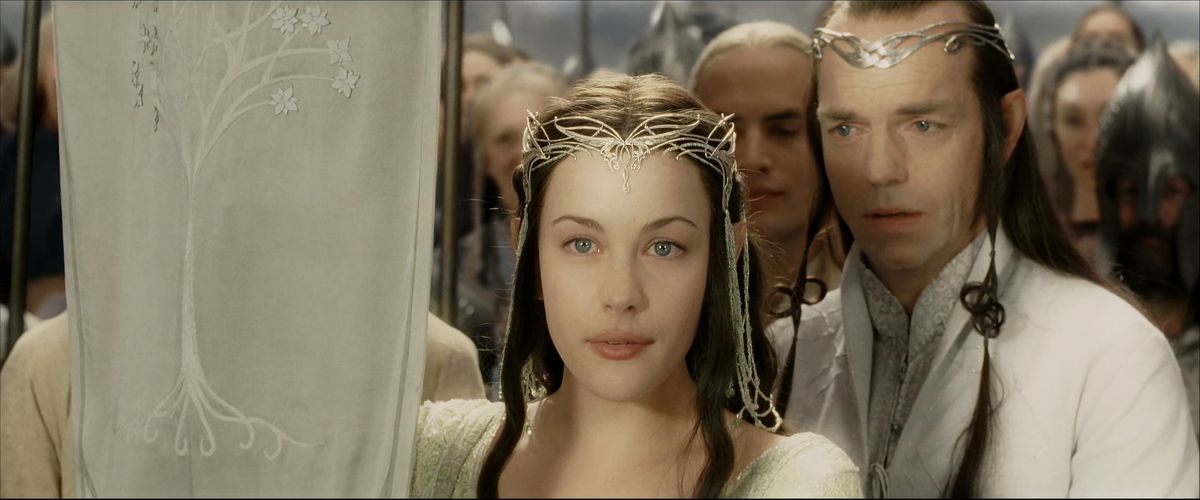
Image: New Line Cinema
Once you notice Hugo Weaving’s face as Liv Tyler steps away from him and into Viggo Mortensen’s arms, you will never look at anything else during this moment. It’s not the look of a father giving a child away in marriage, but the look of a father losing an eternity in paradise with his daughter.
